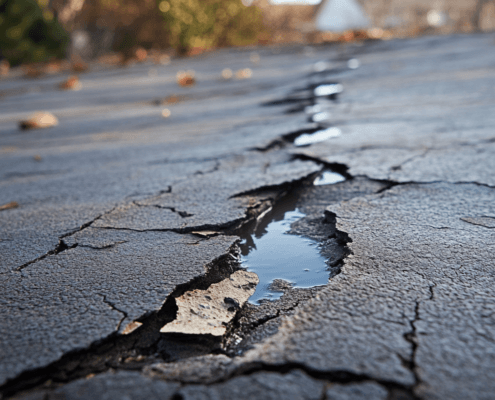Fixing a Flat Roof: A Complete Guide for Business Owners
Fixing a flat roof can seem intimidating, but with the right knowledge and tools, it doesn’t have to be. Whether you’re a business owner or someone managing a commercial building, knowing how to properly address flat roof issues is key to ensuring the longevity of your roof and protecting your property from water damage.
A flat roof is different from traditional sloped roofs. It’s almost level, with just enough slope to allow water to drain off. Because of this, flat roofs often require special attention and repairs to keep them functioning properly. If you’re dealing with a flat roof that needs fixing, here’s everything you need to know about how to approach the repair process.

Visible cracks and pooling water on a flat roof, which requires repair to prevent leaks and further damage.
Why Do Flat Roofs Need Fixing?
Flat roofs can last a long time if they are properly maintained, but there are certain issues that are common to these roofs and can lead to problems. Some of the reasons you might need to consider fixing a flat roof include:
- Water Pooling: Flat roofs are designed with a slight slope, but if the slope is not enough or if drains are blocked, water can pool on the surface. Over time, this pooling water can lead to leaks and even cause the roof to degrade.
- Cracks and Tears: The materials used on flat roofs, such as rubber, TPO, or modified bitumen, can develop cracks or tears over time. These cracks may allow water to seep through and cause leaks inside the building.
- Aging Roof Materials: As flat roofs get older, they may begin to lose their ability to keep water out. If your roof is past its prime, fixing the issues quickly can extend its lifespan.
- Poor Installation: If your flat roof wasn’t properly installed initially, you may experience issues such as poor drainage, cracking, or gaps in seams that require fixing.
Signs That Your Flat Roof Needs Fixing
If you’re wondering whether your flat roof needs fixing, there are a few signs you can look for:
1. Leaks or Water Damage Inside the Building
Water stains on the walls or ceiling are a clear indication that your roof has a leak. If you spot these signs, it’s time to inspect the roof and fix any issues before the problem worsens.
2. Pooling Water
If water is pooling on your roof after it rains, that’s a sign the drainage system is not working as it should. Standing water can cause damage to the roofing material and should be addressed immediately.
3. Visible Cracks or Blisters
If you notice visible cracks or blisters in the roofing material, it’s a sign that your flat roof needs fixing. These can allow water to seep in and cause further damage.
4. Mold or Mildew
Mold or mildew inside your building, especially near the ceiling, can indicate that water is leaking through the roof. You should fix any roof problems immediately to prevent the spread of mold and the associated health risks.
Common Methods for Fixing a Flat Roof
When it comes to fixing a flat roof, there are several methods depending on the type of roof you have and the extent of the damage. Some of the common repair methods include:
1. Patching Small Cracks and Holes
If your flat roof has small cracks or holes, they can often be patched up with roofing cement or rubberized roofing material. This is a simple fix but can prevent more extensive damage if addressed early.
2. Resealing the Roof
If your roof has become worn out or the sealant has worn away, you may need to reseal the entire roof. Resealing prevents water from getting through any cracks or seams. This is often done by applying a fresh layer of sealant or a waterproof coating.
3. Replacing Damaged Sections
In cases where a section of the roof has suffered significant damage, it might need to be replaced entirely. This involves removing the damaged section and installing new roofing material.
4. Repairing Drainage Systems
Proper drainage is crucial for a flat roof. If your roof has clogged gutters or downspouts, water will pool and lead to further damage. Repairing or replacing the drainage system can help prevent these issues from happening in the future.
5. Flat Roof Coatings
Applying a reflective coating to your flat roof is another option for fixing it. These coatings help to protect the roof from UV rays, reduce heat buildup, and extend the roof’s lifespan.
The Steps Involved in Fixing a Flat Roof
If you are considering fixing a flat roof yourself, here are the basic steps to follow. However, for major repairs or a complete replacement, it’s always best to hire a professional roofer.
1. Inspect the Roof
Start by inspecting the roof for damage. Look for signs of wear, pooling water, and any visible cracks. If you are unsure about the extent of the damage, consider hiring a professional roofer for a thorough inspection.
2. Clean the Roof
Before starting any repairs, clear the roof of debris such as leaves, branches, or dirt. This ensures you have a clean surface to work on.
3. Apply Patches to Cracks or Holes
If there are small cracks or holes, use a roofing patch or sealant to fill them. You may need a roofing membrane if the damage is more widespread.
4. Reseal the Roof
For added protection, reseal the entire roof with a high-quality roofing sealant. This will prevent water from entering the roof through the seams or small cracks.
5. Check Drainage Systems
Make sure your drainage systems are clear of debris and functioning properly. Clean gutters and downspouts and check for any blockages.
How to Prevent Future Flat Roof Repairs
To avoid frequent repairs, follow these tips to maintain your flat roof:
1. Schedule Regular Inspections
Get your flat roof inspected at least once a year. A professional inspection will help spot problems early, which can prevent costly repairs later.
2. Clean Your Roof Regularly
Remove debris from your roof and gutters regularly. This will prevent water buildup and reduce the chances of damage to your roofing materials.
3. Maintain Proper Drainage
Ensure that the drainage system on your flat roof is clear and works as it should. Poor drainage is one of the main causes of flat roof damage.
4. Apply Roof Coatings
A protective coating on your flat roof can help protect it from the elements, UV rays, and general wear and tear. Consider applying a new coating every few years.
Frequently Asked Questions About Fixing a Flat Roof
1. How Do I Know When My Flat Roof Needs Fixing?
If you notice leaks, pooling water, visible cracks, or signs of water damage inside the building, your flat roof likely needs fixing.
2. Can I Fix My Flat Roof Myself?
Minor repairs like patching small holes or resealing can be done yourself. However, for major issues or a full roof replacement, it’s recommended to hire a professional roofer.
3. How Much Does It Cost to Fix a Flat Roof?
Repair costs can vary depending on the severity of the damage. Minor repairs might cost between $300 and $500, while more extensive repairs or replacements can range from $1,000 to $3,000 or more.
4. How Long Will a Fixed Flat Roof Last?
A well-maintained and repaired flat roof can last anywhere from 10 to 30 years, depending on the materials used and the quality of repairs.
5. What’s the Best Way to Prevent Fixing a Flat Roof Frequently?
Regular maintenance, including cleaning the roof, ensuring proper drainage, and applying roof coatings, can prevent frequent repairs and extend the roof’s life.
6. What Are the Common Materials Used for Fixing a Flat Roof?
Common materials for fixing a flat roof include EPDM rubber, TPO, modified bitumen, and PVC. These materials are durable and resistant to water damage, making them ideal for flat roof repairs.
Wrapping Up
Fixing a flat roof is essential to maintaining the integrity of your building and preventing water damage. Whether you’re dealing with leaks, cracks, or pooling water, addressing these issues early can save you money and headaches down the road. Regular maintenance, inspections, and proper care will extend the lifespan of your roof and keep your property safe.







